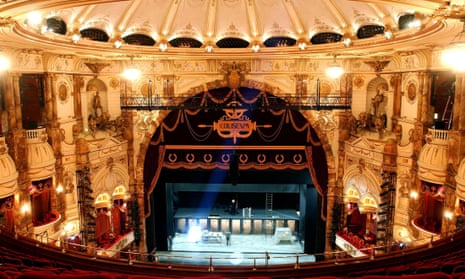David Mellor has this week issued a mea culpa. Not for anything that may or may not have happened when he was “minister for fun” in the dark days of the Major government in the 1990s. But for doing something that at the time he was convinced would make “a major contribution to the cultural life of the nation” - convincing the prime minister to buy the Coliseum, the vast theatre in London’s St Martin’s Lane, for the English National Opera. He now says that decision was “mad”.
The opera-loving Mellor, who had previously been arts minister and would go on to be what we now call culture secretary before falling victim to a Fleet Street kiss-and-tell, was chief secretary to the Treasury at the time. He recalled that he got down on his hands and knees to beg John Major to loosen the cultural purse strings and buy this great theatre for the ENO for £14m “in order that people who do not have Covent Garden money could enjoy a top-class opera experience”.
He now says doing this good turn for ENO was a grotesque mistake, because the board of the opera company has reneged on the deal. Mellor’s charge is that it is acting like a “property landlord”: still claiming its £12m annual subsidy but putting on only 85 performances in the peak London opera season from September to April. Instead, for much of the time it is subletting to commercial musicals and Russian ballet companies, having it both ways by being both a subsidised venue and a commercial theatre.
In one sense, Mellor is of course right. ENO is now a shell of the great and pioneering company it was when Peter Jonas was general director in the 1980s. Under Jonas, director of productions David Pountney and music director Mark Elder, ENO developed enormous self-confidence, great visual elan and an in-your-face aesthetic that combined high camp with raw violence.
If Quentin Tarantino had ever run an opera house, it would have resembled ENO in these so-called “powerhouse” years. Productions such as Jonathan Miller’s New York mafia Rigoletto were huge critical and commercial successes. The Coliseum became the place to be seen, and ENO’s energy and taboo-busting formed a counterpoint to the more genteel world of the Royal Opera House, just up the road in Covent Garden. London could easily accommodate both - the gentleman and the thug.
Unfortunately, the granting to ENO of the freehold to the Coliseum coincided with the break-up of the powerhouse. The charismatic Jonas went off to run the Bavarian State Opera in Munich, and none of his successors over the past 25 years has been able to recapture the excitement of those powerhouse years. The company has lurched from crisis to crisis, financial and artistic. The top jobs have become a revolving door: the last-but-one music director, Mark Wrigglesworth, lasted less than a year. Audiences for its core shows have fallen below 70% capacity, and ENO is being forced to let the house to commercial productions such as The Glenn Miller Story in an attempt to balance the books.
Where Mellor is wrong is in thinking that his wheeze of giving the white elephant of the Coliseum to ENO was a good idea in the first place. With more than 2,300 seats, the theatre is too big for almost any opera company to fill it all year round, day in day out. As audiences fall away, the temptation is to be very conservative in the choice of repertoire. Surefire winners become surefire losers when the audience twigs that theatre managers are just playing a numbers game.

The Royal Opera House has less trouble filling its 2,200 seats – audiences are currently said to be running at about 94% of capacity. One advantage it has over ENO is that with higher-quality performances and a greater cachet, it will always attract the tourist audience.
A night at the opera should be an event. It thrives on drama, excitement, the unexpected; performers stretching themselves to the limit. At Covent Garden you feel that – though in the stalls you may have paid £200-plus for the privilege. Too often at ENO, the productions and performances are routine, just going through the (e)motions. And routine opera is truly terrible.
Barrie Kosky, the Australian-born director of the Komische Oper in Berlin who is noted for his radical, questioning productions, summed up ENO’s dilemma. “What we need to know is the company’s raison d’etre,” he said. “My advice to the management would be to define an identity and convey it forcefully to their audience.” Exactly as he has done with the Komische Oper. When Kosky took over in 2012, it was the poor relation to Berlin’s two big opera houses. Now it competes on level terms. He has won awards, staged rare repertoire, used video techniques as a house signature, attracted a younger audience and created the sort of excitement ENO enjoyed in the Jonas era.
No wonder ENO approached Kosky to see whether he would be interested in applying to be its artistic director when the job became vacant in 2016. He preferred to finish his stint in Berlin. The young and inexperienced Daniel Kramer got the job instead, and has so far been given a difficult baptism by the critics, who are as quick to wield the knife as any Verdi villain.
Kosky’s job in Berlin is made easier by the fact that the Komische Oper only has 1,200 seats – a far more sensible size for the sort of opera house ENO should aspire to be. In the past, everything ENO has done has been viewed through the prism of what was happening at its big brother up the road. The Royal Opera House performed operas in the original language, so ENO should perform in English. The Royal Opera House was pricy; ENO should be a bit cheaper. The Royal Opera House was traditionalist; ENO should be avant garde. It became so used to not being the Royal Opera House that it forgot what it was for - hence the current identity crisis.
So what to do? Leaving the Coliseum would be a good start: too big, too unwieldy, too expensive to run, too close to Covent Garden. A black box, somewhere like Peckham, seating 1,200 or so, would be ideal, preferably with another black box seating 500 next to it for experimental work, open rehearsals, workshops and whatever is required to galvanise a new generation of opera-goers.
Forget about opera in English, or at least don’t be slavish about it. Given the poor enunciation of many singers, often they might as well be singing in Slovenian, and the music will probably drown out large sections of it anyway. ENO clings to it as a comfort blanket, but opera in English is no longer sufficient as the company’s primary purpose.
As Kosky says, the management at ENO have to sit down and ask themselves what the company is really for; what can it uniquely provide? Indeed, perhaps the Arts Council needs to conduct a review of opera in the UK generally, because ENO is not the only struggling company. Do we need two London houses; why is country-house opera booming, while subsidised, city-based opera is struggling; are real-time HD performances in cinemas helping opera or killing it by reducing live audiences in the theatres themselves; why is this most visceral and emotionally direct of art forms still seen by a broad swath of the public as elitist, inaccessible, “not for them”? These are the real issues facing opera. ENO has turned itself into a landlord for a reason – declining audiences, diminishing relevance, a crisis of identity – and that reason poses profound questions for an art form that is always terrified of turning into a museum, and an ill-attended museum at that.

